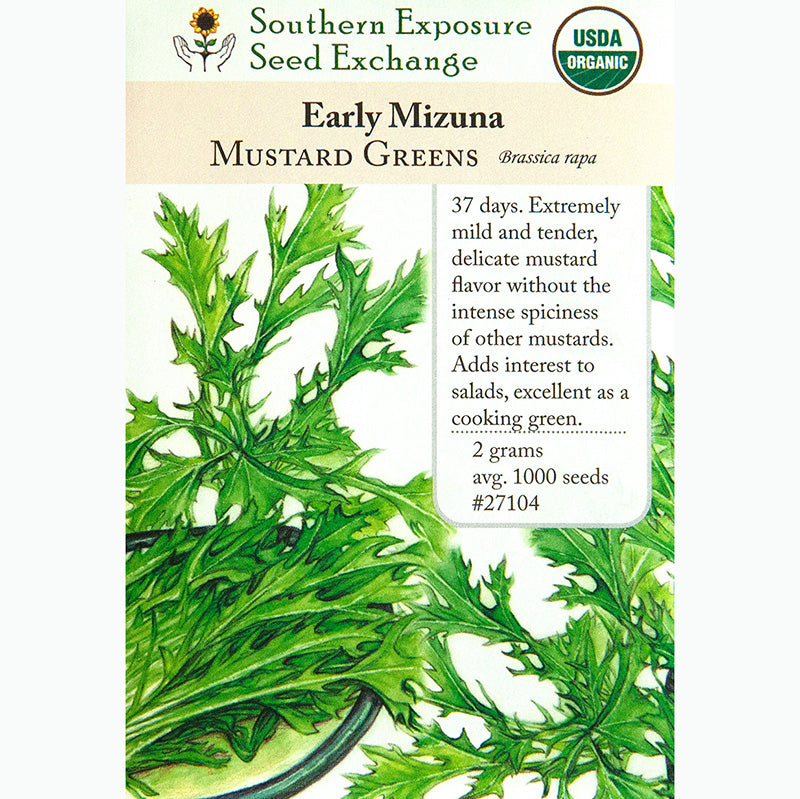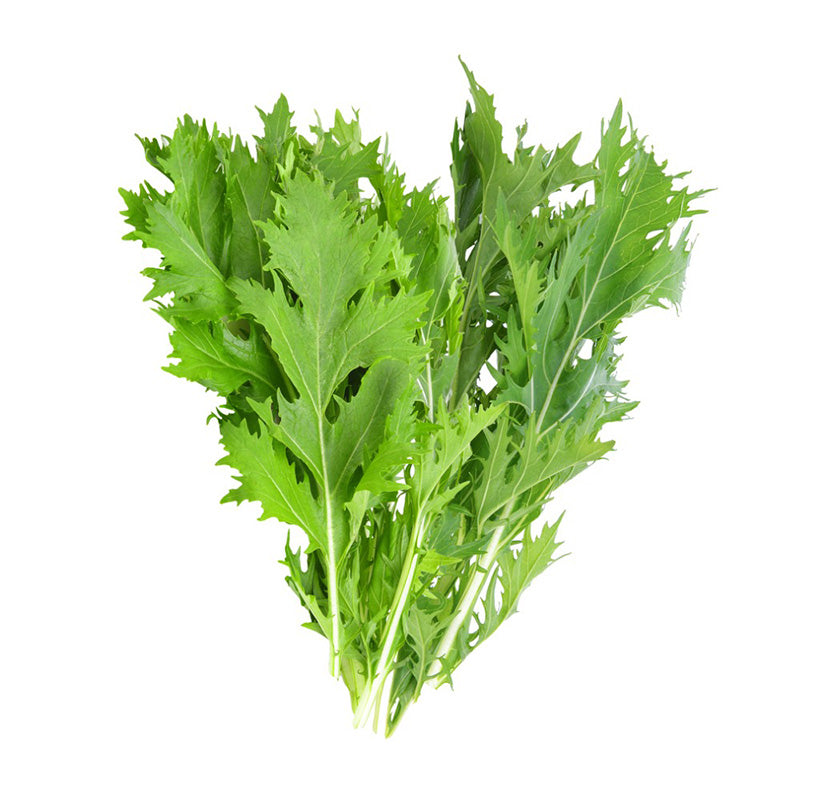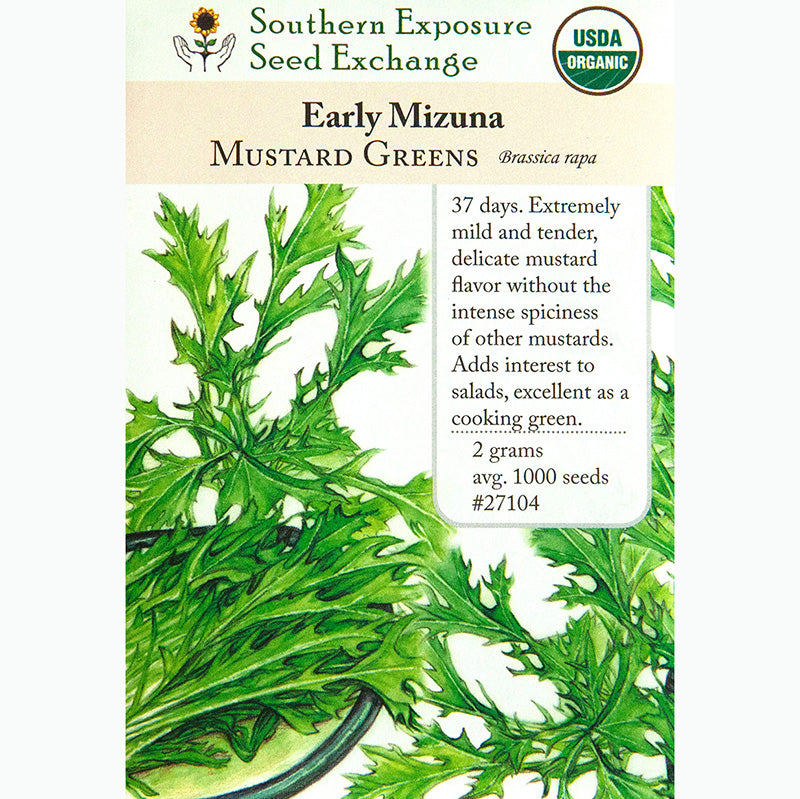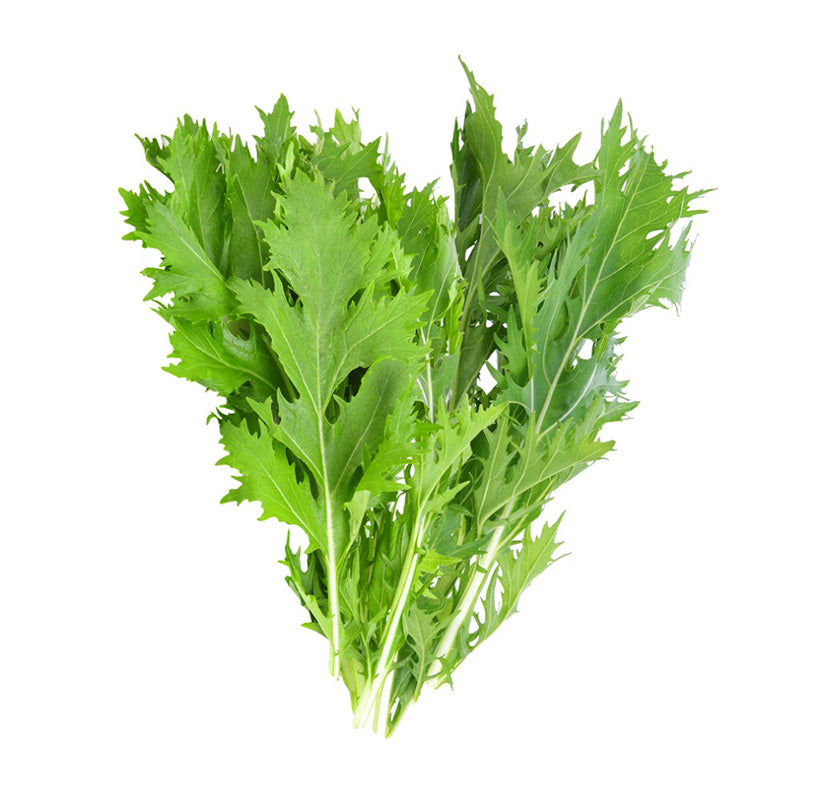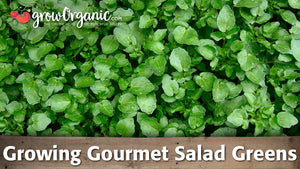Item Number: SNV2011
Early Mizuna Mustard Seeds (Organic)
Early Mizuna Mustard Seeds (Organic)
Zingy Mizuna Mix
Early Mizuna Mustard, a Japanese heirloom, is celebrated for its mild yet peppery flavor and delicate, feathery leaves. Originating from Asia, this mustard variety is a subspecies of Brassica rapa, renowned for its use in both culinary and ornamental settings.
The plant's aesthetic appeal lies in its slender, serrated leaves forming a rosette-like structure. These vibrant green leaves showcase a mild mustard flavor, providing a slight spice to dishes without overpowering the palate. When young, the leaves offer a crisp texture and mild peppery taste, perfect for salads, stir-fries, and garnishes. As the plant matures, the flavor intensifies, adding a zesty kick to various cuisines.
To cultivate Early Mizuna Mustard, sow seeds directly in well-draining soil with adequate sunlight. Plant the seeds about half an inch deep, 1-2 inches apart, in rows roughly 12 inches apart. Optimal germination occurs in cooler temperatures between 45°F to 75°F (7°C to 24°C). Regular watering and adequate spacing aid in healthy growth, allowing the plant to reach maturity in about 40 to 50 days.
Ideal growing conditions include consistent moisture and fertile soil. Mizuna thrives in cooler weather but can tolerate some heat, making it suitable for both spring and fall cultivation. Regular harvesting of outer leaves encourages continuous growth, making it a versatile addition to home gardens and a favorite among culinary enthusiasts seeking a flavorful, nutritious green.





Check Your Zone Compatibility:
Compatible with your zone.
Growing Zone for
,

Our Guarantee To You
Since 1976, we've served our customers at every stage of growing. Please contact us at any time. We are happy to support and assist you.
Description
Description
Early Mizuna Mustard, a Japanese heirloom, is celebrated for its mild yet peppery flavor and delicate, feathery leaves. Originating from Asia, this mustard variety is a subspecies of Brassica rapa, renowned for its use in both culinary and ornamental settings.
The plant's aesthetic appeal lies in its slender, serrated leaves forming a rosette-like structure. These vibrant green leaves showcase a mild mustard flavor, providing a slight spice to dishes without overpowering the palate. When young, the leaves offer a crisp texture and mild peppery taste, perfect for salads, stir-fries, and garnishes. As the plant matures, the flavor intensifies, adding a zesty kick to various cuisines.
To cultivate Early Mizuna Mustard, sow seeds directly in well-draining soil with adequate sunlight. Plant the seeds about half an inch deep, 1-2 inches apart, in rows roughly 12 inches apart. Optimal germination occurs in cooler temperatures between 45°F to 75°F (7°C to 24°C). Regular watering and adequate spacing aid in healthy growth, allowing the plant to reach maturity in about 40 to 50 days.
Ideal growing conditions include consistent moisture and fertile soil. Mizuna thrives in cooler weather but can tolerate some heat, making it suitable for both spring and fall cultivation. Regular harvesting of outer leaves encourages continuous growth, making it a versatile addition to home gardens and a favorite among culinary enthusiasts seeking a flavorful, nutritious green.
Shipping Information
Shipping Information
Shipping Weight: 0.01 lb
Dimensions: 0.1"L x 3.25"W x 4.5"H
Features
Features
- Open-Pollinated
Characteristics
Characteristics
Planting & Care
Planting & Care
Soil & Water: Mustard greens prefers rich, fertile soil with a pH of 6.0-7.5 and plenty of added organic matter. The plants need regular, even moisture to avoid bitterness.
Planting & Growing: Start seeds indoors and transplant out after the last frost, or sow seeds directly a few weeks before the last frost. Use this as a cool-season, end-of-summer crop too, sowing seeds well before the first frost of the fall. Mustard is very cold tolerant.
Harvesting & Storage: Begin harvesting individual leaves after the center rosette has begun to develop. You can begin harvesting at 6" by picking outside leaves. Mustard greens are slow to bolt and are winter hardy.
Useful Information
Useful Information
Guarantee
Guarantee
Share
